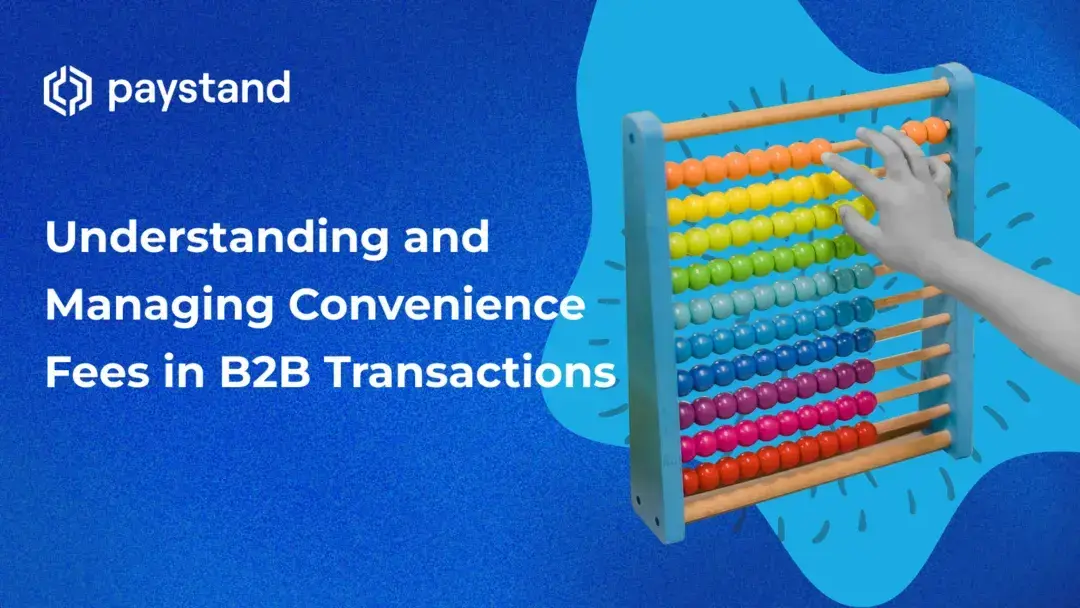Understanding and Managing Convenience Fees in B2B Transactions

Companies constantly seek ways to streamline operations and optimize costs in the dynamic and competitive world of business-to-business (B2B) transactions. However, various fees often complicate financial processes, adding unexpected expenses that can erode profit margins.
Among these charges, convenience fees frequently emerge as a significant concern. This article delves into the intricacies of convenience fees, differentiates them from surcharge fees, and offers actionable strategies for avoiding them. We will also highlight how innovative solutions like Paystand can revolutionize fee management and bolster financial efficiency in B2B interactions.
What is a Convenience Fee?
A convenience fee is an additional business charge when a customer uses a non-standard payment method. This fee is designed to offset the extra costs of processing these alternative payment methods.
What Are Non-Standard Payment Methods?
These payment methods deviate from the primary or preferred methods a business typically accepts. Examples include:
- Credit Card Payments Over the Phone. Many businesses prefer in-person or online credit card transactions due to streamlined processing and lower risk. Accepting credit card payments over the phone can require additional handling and security measures.
- Online Payments Instead of In-Person Payments. Businesses that usually handle in-person transactions may impose convenience fees for payments made through their online portals. This covers the cost of online payment processing systems and the added layers of security required for digital transactions.
- Mobile Apps Payments. If a business typically processes payments via traditional methods like checks or direct bank transfers, they charge a convenience fee for payments made through a mobile app to cover the costs of app maintenance and transaction processing.
In the B2B context, these fees can accumulate rapidly, potentially straining financial resources and impacting the overall cost of doing business.
What Are the Differences Between a Convenience Fee and a Surcharge Fee?
Understanding the distinction between convenience fees and surcharge fees is crucial for businesses aiming to maintain transparent and compliant billing practices:
| Aspect | Convenience Fee | Surcharge Fee |
|---|---|---|
| Definition | Charged for using a more convenient payment method that differs from the business's standard practice. | Specifically covers the cost of credit card transaction fees. |
| Payment Methods | It applies to various non-standard payment methods and is not limited to credit card transactions. | Applied exclusively to credit card payments. |
| Common Examples | Credit card payments over the phone and online instead of in-person payments. | Credit card payments where the fee covers the processing costs. |
| Regulation | Less strictly regulated; businesses have more discretion in applying these fees. | Credit card networks and state laws regulate it. It must be disclosed and cannot exceed a certain percentage of the transaction amount. |
| Disclosure Requirements | It is not as stringent as surcharge fees, though transparency with customers is recommended. | Must be disclosed to customers. |
| Application in B2B Context | Imposed when a client chooses a payment method different from the standard practice, which could include various digital or non-digital methods. | It is explicitly imposed to cover the costs associated with processing credit card transactions in B2B transactions. |
| Fee Basis | Covers additional costs associated with alternative payment methods. | Covers the cost of processing credit card payments. |
| Usage Intent | To offset the extra costs and potential inconveniences of handling non-standard payment methods. | To directly pass on the cost of credit card processing to the customer. |
How to Avoid Convenience Fees?
Reducing or eliminating convenience fees can significantly enhance a business's financial health. Here are several strategies to consider:
- Negotiate Payment Terms. Discussing favorable payment terms with vendors and clients can help businesses avoid convenience fees. Prioritizing payment methods such as direct bank transfers or Automated Clearing House (ACH) payments, which typically incur lower costs, can be beneficial.
- Offer Multiple Payment Options. Providing a variety of payment methods without additional fees encourages clients to choose cost-effective options. Accepting payments through checks, ACH transfers, or electronic funds transfers (EFT) can reduce the incidence of convenience fees.
- Leverage Technology. Modern payment platforms offering low or no fees for certain transactions can streamline financial operations. Advanced payment processors often provide more efficient and economical solutions tailored to B2B needs.
- Educate Clients and Partners. Transparent communication with clients and partners about the cost implications of different payment methods can lead to mutually beneficial agreements. Businesses can foster better financial relationships by highlighting the advantages of cost-effective payment options.
The Role of Paystand
Leveraging advanced payment platforms like Paystand can be a game-changer in minimizing or eliminating convenience fees. Paystand offers a cutting-edge, cloud-based payment network that enables businesses to digitize payments and automate receivables without incurring the typical fees of traditional payment methods.
By harnessing blockchain technology and real-time payments, Paystand facilitates zero-fee bank transfers, alleviating businesses' financial burden.
The Paystand Bank Network
Paystand's preferred payment method is its proprietary Paystand Bank Network, which uses blockchain technology to enable real-time, fee-free bank transfers. This network bypasses traditional banking fees and provides a more cost-effective and efficient payment processing solution. However, Paystand charges convenience fees for purchases not made using the Paystand Bank Network, incentivizing users to adopt this preferred method for its cost and efficiency benefits.
As B2B transactions increasingly migrate to digital platforms, solutions like Paystand provide a compelling means to avoid unnecessary fees, streamline financial operations, and enhance overall efficiency.
By understanding and strategically managing convenience fees, businesses can optimize payment processes, reduce costs, and cultivate stronger relationships with their partners. Embracing innovative solutions like Paystand further amplifies these efforts, ensuring that B2B transactions remain efficient, transparent, and economically advantageous.



